Root Rot Risk in Field Pea and Lentil with Late Seeding into Wet Soils (05/26/22)
Soil-borne root rot pathogens, such as the fungal pathogens Fusarium or Rhizoctonia or the oomycete pathogen Aphanomyces euteiches, thrive under warm soil conditions. The water loving Aphanomyces euteiches is more problematic when soils are wet, particularly during crop emergence (Figure 1). With planting delayed and frequent rains, pea and lentil are at higher risk of developing root rot. Fields with a long history of pulses in close rotations (every 2-3 years) are at greatest risk. Pea and lentil are both affected by Aphanomyces euteiches and thus fields with a history of pea are still at risk for root rot if lentil is planted and vice versa. Recent research conducted at the NDSU Extension Centers highlight the effect higher temperatures at seeding can have on root rot in pea and what benefits can be expected from seed treatment.
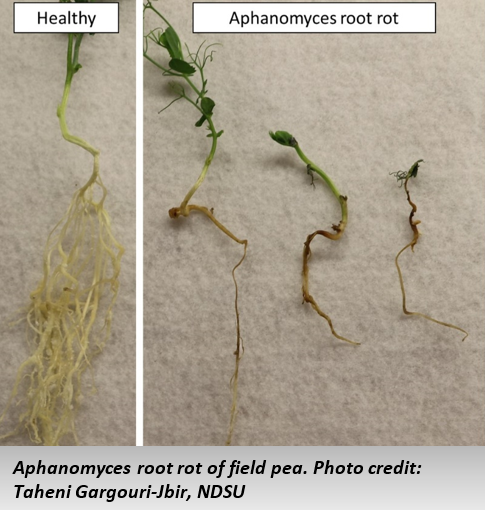
From 2017 to 2020, the Carrington and Williston Research Extension Centers conducted field studies evaluating the impact of planting date on field pea agronomic performance, with studies conducted in Carrington, Williston, and on-farm locations in Mountrail, McLean and Williams Counties. Two sets of studies were conducted: studies planted in fields with no history of root rot but inoculated at seeding with the pathogen causing Fusarium root rot, and studies planted to fields with a history of severe root rot in field pea.
In fields with a history of root rot problems in pea, late planting was associated with increases in root rot severity and this was associated with warmer soil temperatures (Figure 2A). Yields were maximized when soil temperatures at seeding depth averaged 45 to 50°F in the 7 days after planting (Figure 2 B).
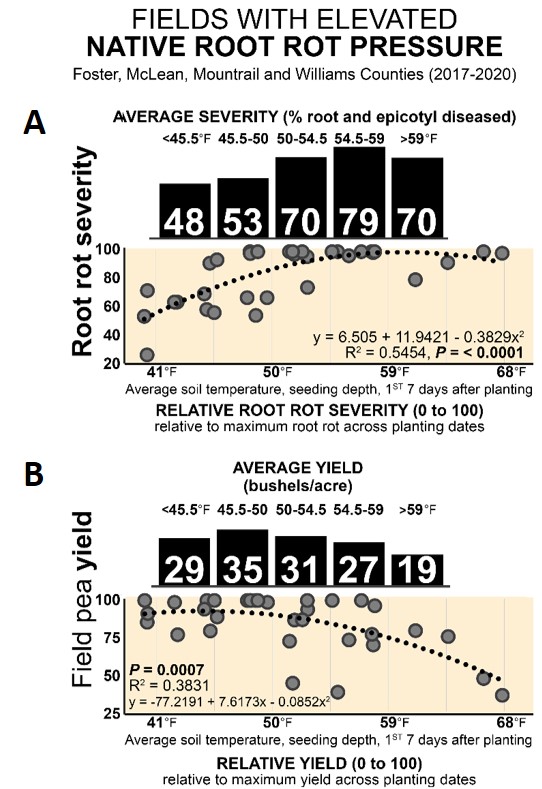
Figure 2 (A & B) Field pea A) root rot severity and B) yield relative to average soil temperatures (at seeding depth, 2 inches deep) in the 7 days after planting. Results are from field studies where peas were planted on three dates 10-14 days apart, generally mid/late April, early May and mid-May. These fields had a history of root rot. Bar graphs show the average response relative to soil temperature observed across all studies. Scatter plots show the relative performance of peas planted at a given soil temperature relative to the two other planting dates conducted in each study.
In fields that did not have a documented history of root rot in pulses but were inoculated with Fusarium, a similar but less dramatic trend was observed but overall root rot severity was lower and yields were higher than fields with a history of root disease (Figure 3A and B).
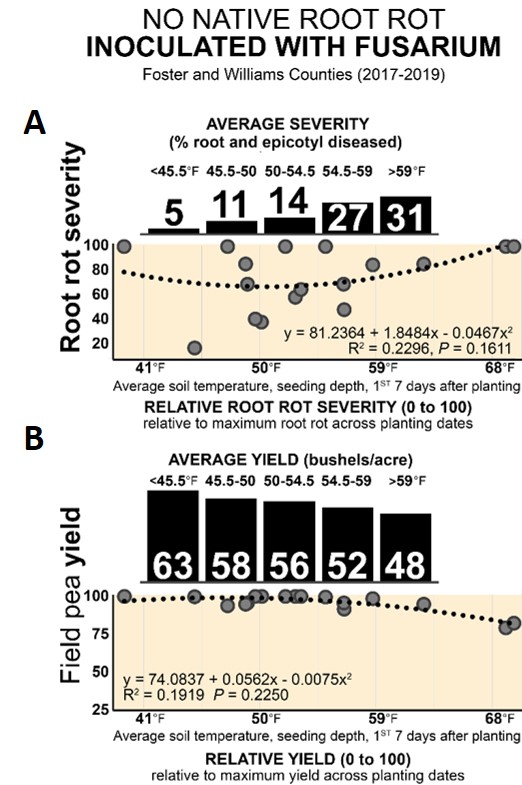
Figure 3. (A & B). Figure 3. (A & B). Field pea A) root rot severity and B) yield relative to average soil temperatures (at seeding depth, 2 inches deep) in the 7 days after planting. Results are from field studies where peas were planted on three dates 10-14 days apart, generally mid/late April, early May and mid-May. These fields had no history of root rot but were inoculated with Fusarium. Bar graphs show the average response relative to soil temperature observed across all studies. Scatter plots show the relative performance of peas planted at a given soil temperature relative to the two other planting dates conducted in each study.
The effect of seed treatment was also considered at sites with a history of root rot. Fungicide seed treatments targeting Pythium, Rhizoctonia, Fusarium and insect pests increased field pea yield by an average 3 to 5 bu/ac (at seeding depth, 2 inches deep) in the 7 days after seeding (Figure 4). The addition of the fungicide ethaboxam (Intego Solo applied at 0.3 fl oz/cwt) with efficacy against Aphanomyces root rot partially offset the yield losses associated with planting peas late (soil temperatures 50 to 59°F in the 7 days after planting) (Figure 5). At sites with no history of root rot, the yield benefit of seed treatment may be less.
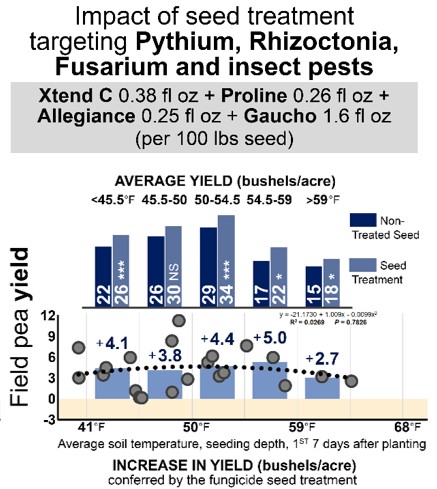
FIGURE 4. Effect of seed treatments targeting Pythium, Rhizoctonia, Fusarium and insect pests on yield relative to soil temperature (at seeding depth, 2 inches deep) in the 7 days after planting. Bar graphs depict the average response relative to the non-treated control, and scatter plots show the response observed in individual planting dates (circles) or average responses across all studies within a range of temperatures (bars).
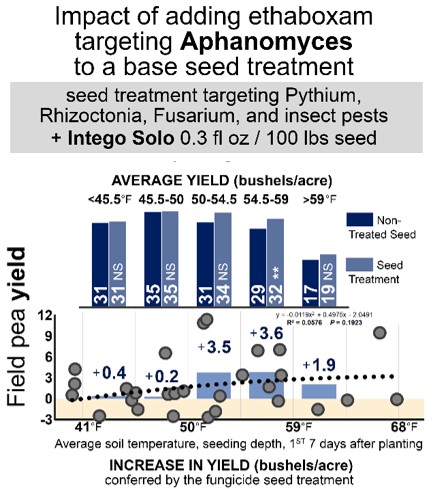
FIGURE 5. Effect of adding the seed treatment ethaboxam (Intego Solo 0.3 fl oz/cwt) targeting Aphanomyces to a standard base seed treatment package on yield relative to soil temperature (at seeding depth, 2 inches deep) in the 7 days after planting.
Having a good crop rotation is key to managing root rot in pulses preventatively. Chickpea, soybean, and faba bean are not susceptible to Aphanomyces euteiches and thus can be included in a rotation with pea and lentil to break up the disease cycle. Growers also may increase the number of cereal and oilseed crops in between planting pea and lentil. Tight rotations will lead to the accumulation of soil-borne pathogens over time, particularly when these crops are planted into warm, wet soils.
For more information of root rot in peas/lentils refer to the NDSU Extension Dry Pea and Lentil Root Rot Management Guide.
Plant Pathologist
NDSU Williston Research Extension Center
Plant Pathologist
NDSU Carrington Research Extension Center
